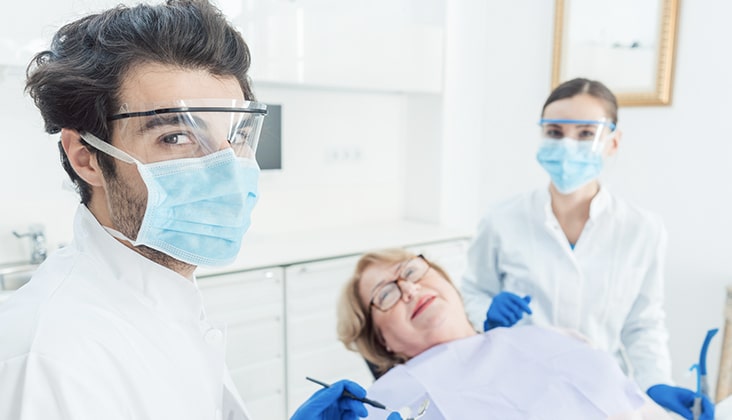
Use of Negative Pressure Isolation in the Provision of Dental Care
| Sean Banaee, PhD, CIH, CSP—assistant professor and director of the Department of Environmental and Occupational Health at Old Dominion University (ODU); Denise M. Claiborne, RDH, PhD—assistant professor and graduate program director, Gene W. Hirschfeld School of Dental Hygiene at ODU; and Muge Akpinar-Elci, MD, MPH—professor and chair, School of Community & Environmental Health, and director of the Center for Global Health at ODU—are blogging for Dimensions of Dental Hygiene on COVID-19. |
By nature, dental hygienists are at high risk of occupational exposure to several types of microorganisms, aerosol particles, and droplets that live in patients’ saliva and blood in addition to instruments contaminated with saliva, blood, and tissue debris.1 These bacteria and fungi may be directly responsible for transmitting highly infectious diseases, including severe acute respiratory syndrome coronavirus 2, Mycobacterium tuberculosis, hepatitis, herpes simplex, and human immunodeficiency virus.1–3
The United States Centers for Disease Control and Prevention (CDC) recommends postponing annual checkups, elective procedures, surgeries, and nonurgent dental visits during the COVID-19 pandemic. If emergency dental care is needed for a patient suspected of having COVID-19, treatment should be performed in an isolation room with negative pressure along with using N95 respirator and a full-face shield for technical team and N95 respirator for other persons entering the room.4
Studies suggest directing airflow through a negative pressure isolation room is a preferred model for protecting healthcare workers during patient care.1,5,6 The Occupational Safety and Health Administration (OSHA)7 provides guidance on preparing workplaces for COVID-19 and defines steps to reduce employee exposure. Engineering controls, such as installing high-efficiency air filters, increasing ventilation rates, and providing negative pressure ventilation, will minimize hazard exposure.
For a negative pressure room, the sum of the mechanically exhausted air must exceed the sum of the mechanically supplied air. In a negative pressure room, air should flow from hallways and corridors (cleaner areas) into the isolation rooms (less clean areas).8,9 This prevents cross-contamination and spread of the virus. CDC guidelines dictate a minimum pressure differential of 0.01-inch water gauge between the exhaust and supply to sustain a negative pressure room. The CDC also defines a minimum of six air changes per hour (ACH) as criteria for an efficient ventilation system (12 ACH for new construction or renovation areas).10
The exhausted air must be directly funneled to the outside of the building as the first option. If this is not possible, the air should be passed through a high-efficiency particulate air (HEPA) filter before recirculation.8 If the exhaust air gets recirculated, a high density HEPA filter with a minimum efficiency reporting value (MERV) of 18 or higher is recommended. MERV 18 is expected to capture 99.97% of particles whose diameter is greater or equal to 0.3 μm. Entry and exit to the room should be minimized, as the doors should be kept closed as much as possible.
Dental professionals are at high-risk because most treatment procedures produce a significant number of aerosols in the environment. Dental professionals who are providing emergency dental procedures during the COVID-19 pandemic, should discuss an office protocol that includes patient, personnel, operatory, and office safety to minimize exposure as much as possible.
References
- Chen C, Zhao B, Cui W, Dong L, An N, Ouyang X. The effectiveness of an air cleaner in controlling droplet/aerosol particle dispersion emitted from a patient’s mouth in the indoor environment of dental clinics. J R Soc Interface. 2010;7;1105–1118.
- LiY, Huang X, Yu IT, Wong TW, Qian H. Role of air distribution in SARS transmission during the largest nosocomial outbreak in Hong Kong. Indoor Air. 2004;15: 83–95.
- Samaranayake L.P, Peiris M. Severe acute respiratory syndrome and dentistry: a retrospective view. J Am Dent Assoc.2004;135; 1292–302.
- United States Centers for Disease Control and Prevention. Dental Settings Interim Infection Prevention and Control Guidance for Dental Settings During the COVID-19 Response. https://www.cdc.gov/coronavirus/2019-ncov/hcp/dental-settings.html
- Cheong KWD, Phua SY. Development of ventilation design strategy for effective removal of pollutant in the isolation room of a hospital. Build Environ. 2006;41:1161–1170.
- US Centers for Disease Control and Prevention. Evaluation of Ventilation Controls for Tuberculosis Prevention at a Hospital. https://www.cdc.gov/niosh/hhe/reports/pdfs/2010-0092-3188.pdf
- Occupational Safety and Health Administration Guidance on Preparing Workplaces for COVID-19. https://www.osha.gov/Publications/OSHA3990.pdf
- LeeJ Y. Tuberculosis infection control in healthcare facilities: environmental control and personal protection. Tuberc Respir Dis. 2016;79; 234–240.
- US Centers for Disease Control and Prevention. Transmission-Based Precautions. https://www.cdc.gov/infectioncontrol/basics/transmission-based-precautions.html#anchor_1564058235
- US Centers for Disease Control and Prevention. Guidelines for Environmental Infection Control in Health-Care Facilities. https://www.cdc.gov/infectioncontrol/guidelines/environmental/background/air.html

